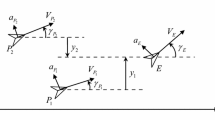Abstract
This article considers the method of developing an evader control strategy in the non-linear differential pursuit-evasion game problem. It is assumed that the pursuer resorts to the most probable control strategy in order to capture the evader and that at each moment the evader knows its own and the enemy’s physical capabilities. This assumption allows to bring the game problem down to the problem of a unilateral evader control, with the condition of reaching a saddle point not obligatory to be fulfilled. The control is realised in the form of synthesis and additionally ensures that the requirements for bringing the evader to a specified area with terminal optimization of certain state variables are satisfied.


Similar content being viewed by others
REFERENCES
Sokolov, S.V. and Shcherban, I.V., Synthesis of optimal strategies of players in minimax problems with incomplete information, Autom. Control Comput. Sci., 2002, vol. 36, no. 4, pp. 20–28.
Shcherban’, I.V., An efficient suboptimal algorithm for player–ally control in a conflict problem, J. Comput. Syst. Sci. Int., 2007, vol. 46, no. 1, pp. 3–8. https://doi.org/10.1134/S1064230707010029
Barkov, V.V. and Kochetkov, Yu.A., Boundary value problem of optimal control of nonlinear determinate systems, Izv. Ross. Akad. Nauk, Teoriya Sist. Upr., 1995, no. 6, pp. 90–95.
Krasovskii, N.N. and Subbotin, A.I., Pozitsionnye differentsial’nye igry (Positional Differential Games), Moscow: Nauka, 1974.
Panteleev, A.V. and Bortakovskii, A.S., Teoriya upravleniya v primerakh i zadachakh (Control Theory in Examples and Tasks), Moscow: Vysshaya Shkola, 2003.
Anan’evskii, I.M., Game-theoretic control problem for a material point of an uncertain mass, J. Comput. Syst. Sci. Int., 2000, vol. 39, no. 4, pp. 503–511.
Baranov, V.A., Game-theoretic methods for stochastic control and decision-making under uncertainty relative to the state in the conditions of the associated base: I, J. Comput. Syst. Sci. Int., 2000, vol. 39, no. 3, pp. 373–382.
Baranov, V.A., Game-theoretic methods for stochastic control and decision-making under uncertainty relative to the state in the conditions of the associated base: II, J. Comput. Syst. Sci. Int., 2000, vol. 39, no. 4, pp. 512–522.
Kuchkarov, A.Sh. and Rikhsiev, B.V., A pursuit problem under phase constraint, Autom. Remote Control, 2001, vol. 62, no. 8, pp. 1259–1262.
Baratova, E.D. and Tarakanov, A.F., Penalty function method and necessary conditions of optimality in a differential hierarchical game under uncertainty, J. Comput. Syst. Sci. Int., 2003, vol. 42, no. 3, pp. 342–348.
Bukov, V.N., Adaptivnye prognoziruyushchie sistemy upravleniya poletom (Adaptive Predicting Flight Control Systems), Moscow: Nauka, 1987.
STANAG 4586 (Edition 3)—Standard Interfaces of UAV Control System for NATO UAV Interoperability, Brussels: Standardization Agency, 2012.
Owings, T.R., Unmanned aircraft systems update, Army Aviation Symp. and Exposition, 2011.
Larm, D., Expendable remotely piloted vehicles for strategic offensive airpower roles, Master’s Thesis, Maxwell Air Force Base, Ala.: Air University, 1996.
Mouloua, M., Gilson, R., Daskarolis-Kring, E.J., Krng, J., and Hancock, P., Ergonomics of UAV/UCAV mission success: Consideration for data link, control, and display issues, Proc. Hum. Factors Ergon. Soc. Ann. Meeting, 2001, vol. 45, no. 2, pp. 144–148. https://doi.org/10.1177/154193120104500231
Nas, M., The changing face of the interface: An overview of UAS control issues and controller certification, Unmanned Aircraft Technology Applications Research Working Group, Murdoch Univ., 2008.
Monje, C.A., Chen, Y.Q., Vinagre, B.M., Xue, D., and Feliu, V., Fractional-Order Systems and Controls: Fundamentals and Applications, Advances in Industrial Control, London: Springer, 2010. https://doi.org/10.1007/978-1-84996-335-0
Shell, K., Applications of Pontryagin’s maximum principle to economics, Mathematical Systems Theory and Economics I/II, Kuhn, H.W. and Szegö, G.P., Eds., Lecture Notes in Operations Research and Mathematical Economics, vol. 11/12, Berlin: Springer, 1969, pp. 241–292. https://doi.org/10.1007/978-3-642-46196-5_12
Author information
Authors and Affiliations
Corresponding authors
Ethics declarations
The authors declare that they have no conflicts of interest.
About this article
Cite this article
Shcherban, I.V., Ivanov, S.V. & Shcherban, O.G. An Evader Control Strategy in the Non-Linear Differential Game Problem with Terminal Limitations. Aut. Control Comp. Sci. 56, 143–149 (2022). https://doi.org/10.3103/S0146411622020092
Received:
Revised:
Accepted:
Published:
Issue Date:
DOI: https://doi.org/10.3103/S0146411622020092




